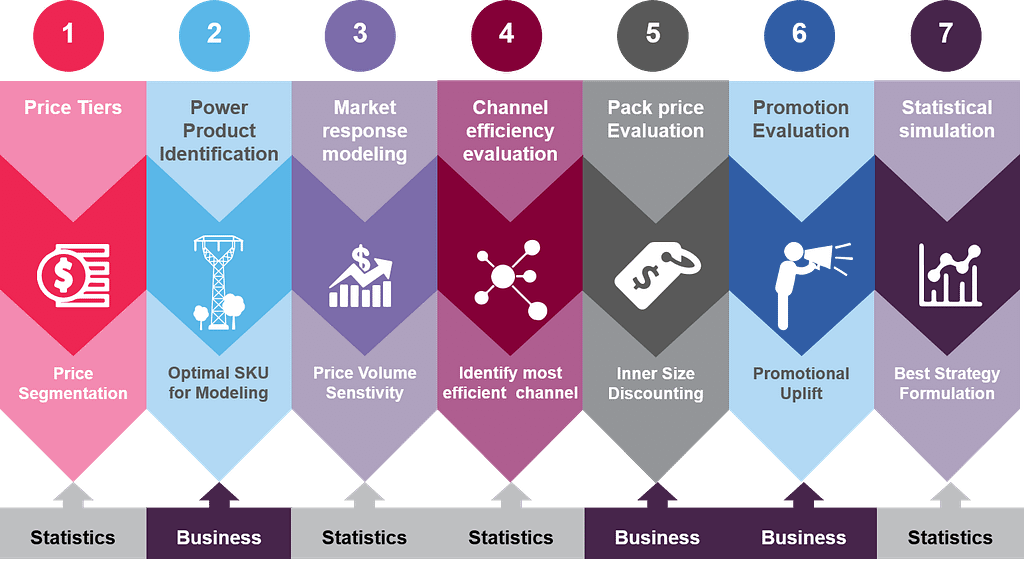Pricing can determine whether your business succeeds or fails, which is why it’s a strategic priority for every organization. If you want to price your product to maximize sales, market share or profit, you need an effective pricing strategy—and analytics can help.
How firms deal with pricing depends on their aims and the competitive landscape they are facing. Ideally, you want to maximize value and market share by selling your most profitable products through the most efficient channels.
Most firms think about elements of the marketing mix such as product, place and promotion. But few take the next step of carrying out sensitivity analyses and pinpointing optimal prices based on “What if?” scenarios.
The diagram below shows a step-by-step description of analytics-driven pricing for a consumer packaged good in the B2C arena. (It could also be adapted to B2C services with minor alterations.) The rest of this post looks at the seven steps in turn.
Step 1: Identify Price Tiers
You can break down a product category into three or four price tiers—such as value, mainstream and premium—according to consumer purchase patterns. You need a unique offering in each tier, so you’re actively competing at every level. Any offering with a price that takes it across tier boundaries will just confuse consumers and harm value creation. In statistical terms, analyzing tiers is carried out with clustering techniques;
Step 2: Identify Power Products
Once you know your price tiers, you can move on to price modeling. Since modeling individual products is complex, a more efficient approach is to select those that generate maximum sales (volume) or market share per unit of distribution cost. These are your power products.
Certain types of product should be excluded automatically. Newly launched strategic products are inherently inefficient due to low distribution and sales, while end-of-life products are inefficient due to high distribution and low sales.
Step 3: Market Response Modeling
The next step is Market Response Modeling, also known as Price Sensitivity Analysis. This helps you understand the impact of pricing decisions based not only on what competitors are offering, but what you’re offering too—that is, the potential threat of “cannibalizing” your own products by competing against yourself.
You need reliable predictions of how the market is likely to react to different price points. This is done by developing regression based log-log models for product elasticity, cross elasticity and cannibalized product offerings. Such models regress volume vs. competitor offerings and cannibalized sales from internal products using six months’ historical data for competing internal and external products. Co-relation (value < -0.7) is used to identify relevant competitor and cannibalized products, against which a market response model can be built.
Step 4: Evaluate Channel Efficiency
Many manufacturers offer deep discounts to stimulate demand, which brings sales variance analysis to the fore. By harnessing machine learning, firms can customize the discounts they offer based on product preferences and regions.
Another aspect to channel efficiency is shelf space with channels/retailers. Since space is limited and competitors want it too, firms must essentially pay to secure it. This is sometimes called the retailer/channel margin. Clearly, this affects profit, so firms want to know which retailers/channels generate the most revenue per unit cost (the retailer margin). This can be done through statistical benchmarking techniques such as Data Envelopment Analysis.
Step 5: Evaluate Pack Price
Consumer products such as drinks, dry goods and cosmetics are frequently sold in a range of pack sizes, with larger discounts for bigger packs. So firms need to evaluate relative pricing across various packs to make sure they don’t offer too much discount while maintaining an effective positioning against competitors in every price tier.
Step 6: Evaluating Promotions
There are many reasons to run promotions, from building long-term brand equity to offloading end-of-life products and defending market share against competitors. Each promotion involves several decisions: what packs it will appear on, the depth of the promotion and mechanisms such as bonus pack, multi pack, buy one get one free, buy get premium trail pack and so on. To make all these decisions optimally, firms need to evaluate the short- and long-term sales uplift they get from promo campaigns. This can be done through pre-, post-based test control full-factor design experiments.
Step 7: Strategic Simulation
Finally, firms want to use pricing to maximize their profits/outlet sales at brand/segment level so as to constrain market share. As both are inversely related, there is a sweet spot or ideal case for optimal price given market share, and it needs to be determined. Another key constraint is that products should be sold through the most efficient channels. All this can be analyzed using statistical optimization techniques. The graph shows an example.
Further post-optimal analyses (sensitivity analyses) are run to ensure alignment with strategic priorities. For example, the firm may want to focus on strategic channels that may not be mathematically significant, or may wish to prioritize market share over profits.
One way to deal with inefficient products is to opt for competitor-based pricing. This is done through price cliff (price corridor) analysis, which uses R-S type control charting (price per unit vs. volume share gap) to identify white spaces within which neither increasing or decreasing prices is detrimental to market share. If product pricing outside this corridor, it is off-strategy. Relevant products for analysis are identified through co-relation.
Finally, it’s important to note that analytics is a complex and sometimes cumbersome job. It requires input from both analytics and business teams, and also imposes a variety of data requirements. How you implement it depends on your long-term strategy.
If you want to implement a uniform pricing strategy, you can go for a full-blown solution that you develop for one category and then roll out to others. If, on the other hand, you’re just starting out with analytics-based pricing, or if you have budgetary constraints, you can “pick and mix” from the menu of options set out in this post.



